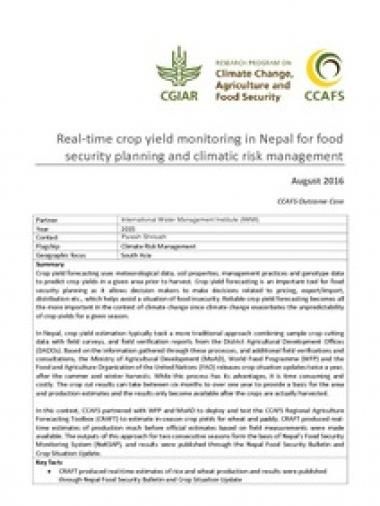Real-time crop yield monitoring in Nepal for food security planning and climatic risk management

Crop yield forecasting uses meteorological data, soil properties, management practices and genotype data to predict crop yields in a given area prior to harvest. Crop yield forecasting is an important tool for food security planning as it allows decision makers to make decisions related to pricing, export/import, distribution etc., which helps avoid a situation of food insecurity. Reliable crop yield forecasting becomes all the more important in the context of climate change since climate change exacerbates the unpredictability of crop yields for a given season.
In Nepal, crop yield estimation typically took a more traditional approach combining sample crop cutting data with field surveys, and field verification reports from the District Agricultural Development Offices (DADOs). Based on the information gathered through these processes, and additional field verifications and consultations, the Ministry of Agricultural Development (MoAD), World Food Programme (WFP) and the Food and Agriculture Organization of the United Nations (FAO) releases crop situation updates twice a year, after the summer and winter harvests. While this process has its advantages, it is time consuming and costly. The crop cut results can take between six months to over one year to provide a basis for the area and production estimates and the results only become available after the crops are actually harvested.
In this context, CCAFS partnered with WFP and MoAD to deploy and test the CCAFS Regional Agriculture Forecasting Toolbox (CRAFT) to estimate in-season crop yields for wheat and paddy. CRAFT produced real-time estimates of production much before official estimates based on field measurements were made available. The outputs of this approach for two consecutive seasons form the basis of Nepal's Food Security Monitoring System (NeKSAP), and results were published through the Nepal Food Security Bulletin and Crop Situation Update.
Citation
CCAFS. 2016. Real-time crop yield monitoring in Nepal for food security planning and climatic risk management. CCAFS Outcome Case. Copenhagen, Denmark: CGIAR Research Program on Climate Change, Agriculture and Food Security (CCAFS).